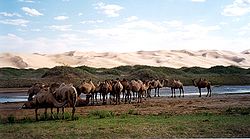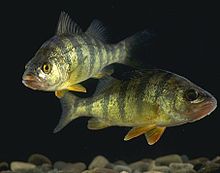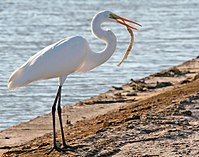Wildlife of Mongolia

The wildlife of Mongolia consists of flora, fauna and funga found in the harsh habitats dictated by the diverse climatic conditions found throughout the country. In the north, there are salty marshes and fresh-water sources. The centre has desert steppes. In the south, there are
About 90% of the landlocked country is covered by deserts or pastures with extreme climatic conditions. Fauna in the wild includes 139 mammal species, 448 bird species (331 of which are migratory and 119 are resident), 76 fish species, 22 reptile species and 6 amphibian species.[2][4][5] Grassland and shrubland covers 55 percent of the country. In the steppe zone, forest covers only 6 percent while 36 percent is covered by desert vegetation, and only 1 percent is used for human habitation and agriculture.[4] The vegetation in the eastern steppe region is grassland (the largest of its type in the world).[6]
Geography
Topography
The country is bounded by Tibet, Afghan Turkestan, Siberia, and Northeast China. This has resulted in a faunal richness that combines the species from each of the border nations.[7] Habitat distribution consists of grassland, shrubland and forest covering 55 percent of the country, while forest cover is 98 percent in the steppe zone[clarification needed], 36 percent is covered by desert vegetation.
Water resources


The drainage pattern is dictated by Asia's
Climate
The climatic conditions dictated by the oceans on one side and the snow-capped mountains (average peak elevation of 5,180 metres (16,990 ft) in high northern latitudes) on the other side, have a significant bearing on the wildlife distribution in the country. The climate patterns are: continental climate with very cold conditions (anticyclones are formed here over Siberia) and cool to hot summers in the deserts and semi deserts. Temperature records indicate a very wide variation between winter and summer, of the order of 80 °F (44 °C) on average in the northern part of the country, and even on a single day the variation can be as much as 55 °F (31 °C). In the Ulaanbaatar area the typical variation reported is −7 °F (−22 °C) in January and 63 °F (17 °C) in July while in the Gobi desert area, the average temperature reported for January is 5 °F (−15 °C) and 7 °F (−14 °C) in July.[8]
Precipitation
Rainfall and snow are also very uneven, dependent on elevation and latitude. Annual amounts range from low-lying desert areas of the south and west where it is less than 4 inches (100 mm) to northern mountainous areas, where it is reported as about 14 inches (360 mm), while at Ulaanbaatar the reported annual rainfall is 10 inches (250 mm). The number of days the sky remains clear and sunny is between 220 and 260 annually. Fierce blizzards occur in the mountain regions and the steppes. During this period a thin layer of snow totally stops grazing in these pastures.[8]
Legal protection
Commercial exploitation increased between the seventeenth and twentieth centuries, necessitating increased legislation. Two laws were enacted in 1995, the Mongolian Law on Environmental Protection and the Mongolian Law on Hunting.[10] The steppe habitat for Mongolian gazelle (Procapra gutturosa), an area of 275,000 square kilometres (106,000 sq mi), is reported to be the "largest remaining example of a temperate grassland ecosystem".[11]
Protected areas

Immediately after Mongolia attained independence in 1990, there was enthusiasm to declare 100 percent of the country as a national park. However, the goal was set at an achievable 30 percent. But due to economic conditions dictating development of mines, the achievement so far has been of the order of 13.8 percent covering an area of 215,200 square kilometres (83,100 sq mi) spread over 60 protected areas. There are four categories of protected areas, and these are: strictly protected areas (prohibiting hunting, logging and development with no human habitation as the defined areas are very fragile); the national parks, with their historical and educational interest providing for ecotourism in identified areas and with limited access to the local nomads for fishing and grazing; natural and historic monuments with restricted developmental activities; and nature reserves of less important regions providing protection to endangered and rare species of flora and fauna and archeological value with limited access for development within prescribed guidelines.[12] The strictly protected areas are
Some of the other protected are:[17]
- Strictly protected areas

- Khasagt Khayrkhan (27,400 hectares (68,000 acres))
- Khukh Serkhiin Nuruu (65,900 hectares (163,000 acres))
- Khan Khentii Uul (1,227,000 hectares (3,030,000 acres))
- Otgon Tenger Reserve(95,500 hectares (236,000 acres))
- Numrug (311,200 hectares (769,000 acres))
- Mongol Daguur Biosphere Reserve (103,000 hectares (250,000 acres))
- National parks
- Gobiin Gurvan Saykhan (2,171,737 hectares (5,366,480 acres))
- Khovsgul Nuur (838,100 hectares (2,071,000 acres))
- Khorgo Terkh Zagaan Nuur (77,267 hectares (190,930 acres))
- Gorkhi Terelj (286,400 hectares (708,000 acres))
- Altai Tavan Bogd National Park
- Tsambagarav Uul National Park
- Khustain Nuruu National Park
- Lake Khövsgöl National Park
- Southern Altai Gobi National Park
- National reserves
- Ugtam Uul (46,160 hectares (114,100 acres))
- Lkhachinvandad Uul (58,800 hectares (145,000 acres))
- Bulgan Gol(7,700 hectares (19,000 acres))
- Sharga and Mankhan (316,900 hectares (783,000 acres))
- Khustain Nuruu(49,940 hectares (123,400 acres))
- Nagalkhan Uul (3,000 hectares (7,400 acres))
- Batkhan Uul
- Gun-Galuut Nature Reserve
- National monuments
- Eej Khairkhan (22,500 hectares (56,000 acres))
- Bulgan Uul (1,800 hectares (4,400 acres))
- Togoo Tulga Uul (1,665 hectares (4,110 acres))
- Naiman Nuur (11,500 hectares (28,000 acres))
- Ganga Nuur (32,860 hectares (81,200 acres))
Flora

The flora in the wildlife area of Mongolia is of pasture lands in three-fourths of the country, which is the main source of feed for the large quantity of livestock. Forests and barren deserts cover the remaining area in the country.
Fauna
There are 139 mammal species found in Mongolia, and 448 species of birds.[2]
Mammals
Mongolia has a number of large mammals, including
The
Under the
Birds
The bird species in Mongolia include several that are very large. Six species of cranes present in Mongolia account for half the numbers in the world.
Aquatic life

The rivers and lakes of Mongolia are reported to have 76 species of fish, including
Threats and conservation
In a country where Russia was supporting the economy with grants until it became independent in 1990, the situation drastically changed after independence. The country's revenue then depended more from the wildlife resources and its landscape, which were subject to serious exploitation necessitating a policy change towards ecotourism to generate revenue to preserve the remaining biodiversity of the country.[25] Other than official action to raise resources of the state, other major threats faced are illegal hunting (for musk deer, elk, boars, squirrels and marmot for illegal trade), grazing of pasture livestock and related needs of water resources (due to large increase in livestock population since 1990), climate change, fires in steppe and forests (resulting in death of many animal species) and severe cold and drought.[26]
For conservation of the rich biodiversity of the country, the
References
- ^ "What's the largest desert in the world? (Hint: It's not the Sahara)". ZME Science. 15 July 2020. Retrieved 16 June 2022.
- ^ a b c d e "Wild life". National Geographic Offroad Expeditions Wild life. Retrieved 1 May 2013.
- ISBN 978-0-7614-4849-5. Retrieved 1 May 2013.
- ^ ISBN 978-1-74104-578-9. Retrieved 1 May 2013.
- ^ a b c "Mongolia". Wildlife Conservation Society. Retrieved 1 May 2013.
- ^ a b "Wild Life Issues in Mongolia". Iberia nature.com. Retrieved 1 May 2013.
- ^ a b "Mongolia: Animal life". Encyclopædia Britannica, Inc. Retrieved 2 May 2013.
- ^ a b c d "Mongolia: Drainage". Encyclopædia Britannica, Inc. Retrieved 2 May 2013.
- ^ Kohn 2008, pp. 50–51.
- ISBN 978-0-7007-1598-5. Retrieved 30 April 2013.
- ISBN 978-0-549-78947-5. Retrieved 30 April 2013.
- ^ a b Kohn 2008, p. 52.
- ^ "Bogd Khan Uul Biosphere Reserve". UNESCO. Retrieved 3 May 2013.
- ^ "Great Gobi Biosphere Reserve". UNESCO. Retrieved 3 May 2013.
- ^ "Uvs Nuur Basin, Russian Federation, Republic of Tuva and Mongolia". Encyclopaedia Earth Organization. Retrieved 3 May 2013.
- ^ "Dornod Mongol Biosphere Reserve". UNESCO. Retrieved 3 May 2013.
- ^ "The National Parks and Nature Reserves of Mongolia". Nationalparks-worldwide.info. Retrieved 3 May 2013.
- ^ "Mongolia". Encyclopædia Britannica. Retrieved 2 May 2013.
- ^ a b Kohn 2008, p. 51.
- ^ a b c d "Wildlife in Mongolia:Species Conservation work with WWF Mongolia". World Wildlife Fund. Retrieved 1 May 2013.
- ^ "Mongolia". The Zoological Society of London. Retrieved 2 May 2013.
- ^ a b Kohn 2008, p. 50.
- ^ ISBN 9781841621784.
- ^ ISBN 92-5-104309-4.
- ^ Kohn 2008, p. 48.
- ^ "Wild Life Issues in Mongolia" (PDF). WWF Mongolia Programme Office. Retrieved 2 May 2013.
Bibliography
- Michael Kohn (2008). Mongolia. Lonely Planet. pp. 51–. ISBN 978-1-74104-578-9. Retrieved 2 May 2013.


